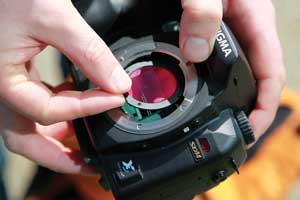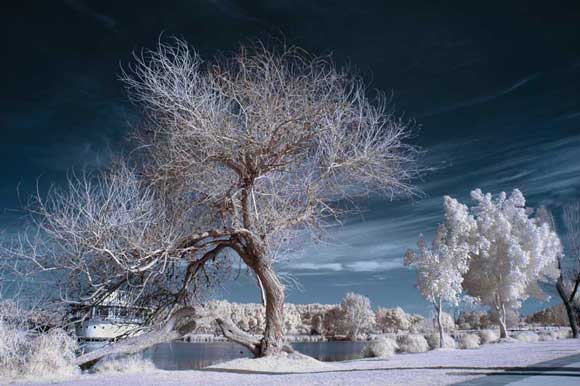How To Shoot Infrared – Before You Go
Checking Your Camera for IR Filters
The chances are your camera will have some form of infrared protection on its sensor, but depending on the model it should still let some IR light through. The easiest way to check is using your standard TV remote control. Almost every remote uses infrared to send signals back to the device, so by pointing it at your camera and pressing the buttons you can check if your camera can see it. If your camera has live view or you’re using a compact, simply watch the screen on the back and look for a red dot on the end of your remote. Otherwise, sit your camera on a tripod and take a picture while pointing and pressing the remote towards the camera. Try doing this in a darkened room for the best results – you may need to ramp up your ISO or use a slow shutter speed. If you can see a red dot, your camera can see infrared light, and you’re good to go.
Removing the filter
 Sigma’s SD14 has a removable infrared and dust blocking filter mounted right behind the lens mount. Simply remove the lens and push the filter up to release. Most other cameras need professional conversions to remove this filter.
Sigma’s SD14 has a removable infrared and dust blocking filter mounted right behind the lens mount. Simply remove the lens and push the filter up to release. Most other cameras need professional conversions to remove this filter.
Have your camera Converted
If you’re serious about infrared and want to take more than the odd snap, you can always have your camera specially adapted to see more infrared light. ACS is currently the only company in the UK offering a service to convert your camera for infrared use. Starting from just £290, the sensor can be filtered to allow just IR or IR and visible light using a clear Quartz filter. With the infrared filter on your sensor rather than the lens, you can then continue to use your viewfinder as normal, and exposure times remain short enough to handhold. This process means your camera will then only take infrared shots but if you have an old DSLR that you no longer use, sat in your draw at home, this could give it a new lease of life. For more information contact: www.advancedcameraservices.co.uk or phone 01953 889 324.
Dedicated IR cameras
Not all cameras have been designed to resist infrared light. These three models (right) have been specially designed to include the longer wavelengths for specialist use such as astronomy and forensic work, making them ideal for IR fans. They all still allow visible light through, though, so you would still need to use an IR filter for true infrared results.
Know Before You Go!
Test your camera
Can your camera see infrared light? Try the remote control test (see facing page), and for best results consider having an old camera converted or use the Sigma SD14.
Get an IR Filter
To block out all visible light from your sensor, for true infrared results (unless your camera has been converted) you’ll need an IR filter over your lens – see next page.
Set white balance
If you want your plant life to glow white in your image, set a manual white balance value before you start shooting by pointing at some green grass with the filter on.





